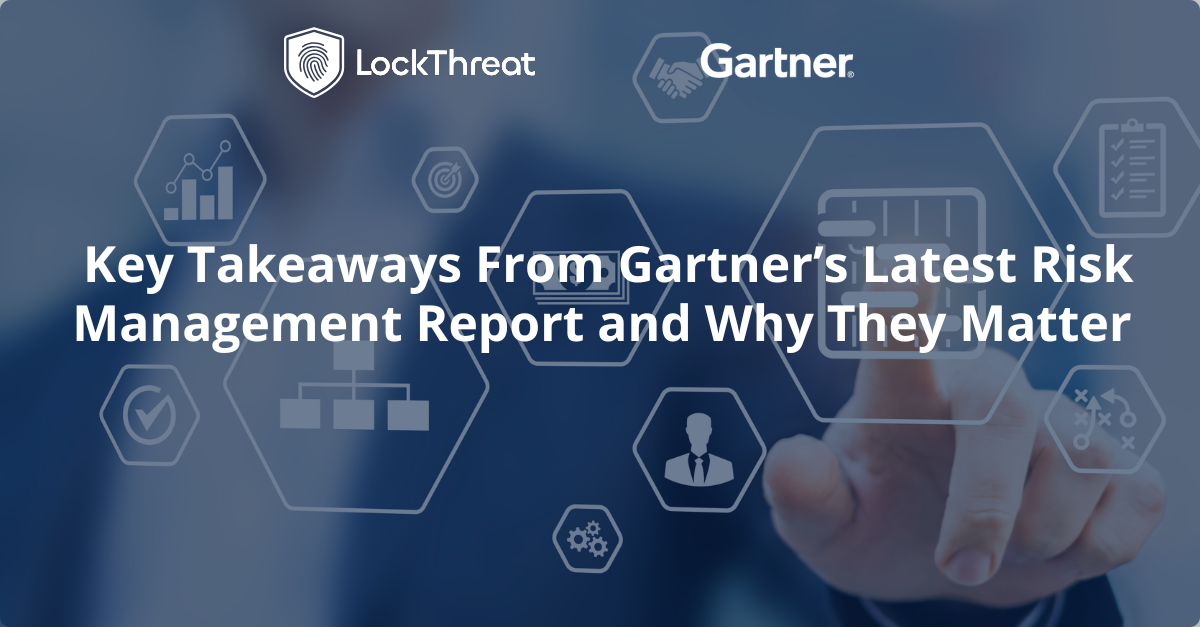Back to blog
August 8, 2025
Key Takeaways From Gartner’s Latest Risk Management Report

The way organizations approach risk is undergoing a profound shift. Gartner’s latest report, 5 Ways to Apply Data & Analytics to Your Risk Management Process, reinforces what we at LockThreat have long anticipated: risk management must evolve to match the complexity and speed of today’s data-driven business environment.
The era of reactive, spreadsheet-driven risk practices is giving way to dynamic, analytics-powered programs. Forward-thinking organizations are already leading that transition.
We’re proud that LockThreat has been featured as a Disruptor GRC Solution in the report. To us, this is more than recognition. It is validation of our vision to deliver a flexible, integrated, and insight-driven GRC platform that meets the evolving needs of today’s risk, compliance, and security leaders.
Here are the top takeaways from the report, why they matter, and how they align with the work we’re doing at LockThreat:
1. Structured data is not enough
Gartner highlights a long-standing issue: most organizations still rely heavily on spreadsheets or structured data to manage risk. But risks rarely appear in neat rows and columns anymore.
At LockThreat, our platform is designed to ingest and analyze a broad spectrum of data types, including structured, semi-structured, and unstructured sources such as regulatory feeds, internal audit findings, and external intelligence. A broader data foundation creates a more complete and actionable risk picture.
2. Risk labels like high, medium, and low are losing relevance
The report makes it clear that more organizations are moving toward risk quantification. Numeric modeling brings clarity and precision, enabling leaders to understand potential impact and make faster, data-backed decisions.
LockThreat supports a range of quantification methods, from simple scoring to scenario-based analysis. This helps risk teams speak the same language as the board and align risk decisions to business outcomes.
3. GRC platforms need to be simple and scalable
Legacy GRC systems tend to be rigid, siloed, and difficult to configure. Gartner emphasizes the need for agile solutions that make risk management more accessible and aligned with how teams actually work.
LockThreat was built to be user-friendly, integration-ready, and adaptable. Our no-code workflows and modular architecture allow teams to scale quickly without added complexity.
4. Real-time risk monitoring is essential
According to Gartner, quarterly reviews and static dashboards are no longer enough. Organizations need tools that surface risk insights in real time.
With LockThreat, teams can continuously monitor key risk indicators, trigger alerts, and stay ahead of emerging threats. Our real-time dashboards provide the visibility needed to act before issues escalate.
5. Reporting should serve the whole organization
Gartner calls out a major challenge: most GRC reporting is time-consuming and misaligned with stakeholder needs.
We built reporting in LockThreat to be fast, flexible, and customizable. Whether presenting to the board or reviewing internally, users can generate clear, tailored reports in just a few clicks.
What being called a Disruptor means to us?
Being featured in this report is an honor, but more importantly, it validates that the GRC landscape is changing. Risk leaders are looking for modern tools that are smarter, faster, and easier to use. That’s exactly what we are building at LockThreat.
If you're evaluating how to improve your GRC program, modernize your approach to risk, or move beyond spreadsheets sprawl and legacy tools, we’d love to show you how LockThreat can help.
Book time with one of our GRC experts.
On This Article
